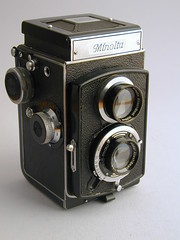Minoltaflex (I)
See also the 1941 Minoltaflex Automat, the later Minoltaflex Automat prototypes and the postwar Minoltaflex II and III.
The Minoltaflex[1] (ミノルタフレックス, later termed the "Minoltaflex I")[2] is a 6×6cm TLR (twin lens reflex) camera for 120 film, introduced by Chiyoda Kōgaku (predecessor of Minolta) in late 1937.
Contents
Second Japanese TLR
The Minoltaflex is often wrongly presented as the first twin-lens reflex camera sold in Japan;[3] it was actually the second, released some months after the Prince Flex by Neumann & Heilemann. It is likely that the Minoltaflex prototypes came first, and it is said that the announce of the Prince Flex was precipitated by the news that the Minolta camera would be released soon.[4] The production of the Prince Flex faced many problems and only a handful were made, whereas the Minoltaflex was almost unmodified during its five-year production, and was a commercial success given the conditions. Various competitors appeared afterwards, the most successful being the Lyra Flex, First Reflex and Rollekonter.
Description
The Minoltaflex is essentially a copy of the Rolleicord. The front plate is moved back and forth for focusing, driven by a knob on the photographer's right. This knob has a chrome finish with a black top, and is graduated from ∞ down to 0.8m; it runs along a black depth-of-field scale showing indications for 3.5, 8 and 16 apertures.
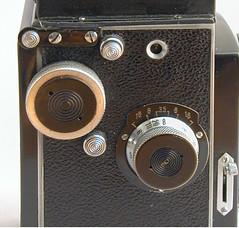
|
| Picture by eBayer hbpartner. (Image rights) |

|
| Red window underside. (Image rights) |
The film advance is semi-automatic, driven by a knob placed on the photographer's right, with the same black and chrome finish as the focus knob. The advance knob automatically stops for each exposure, and there is a small round window for a frame counter on the same side, at the top. After each exposure, the advance mechanism is manually unlocked by pressing a button placed above the advance knob.[5]
The L-shaped back is hinged at the top and retained by a latch at the bottom; the serial number is inscribed inside. There is an exposure table attached behind the back on most examples; it is written in English, something which is rather surprising for a Japanese camera of the time. The two film flanges placed on the photographer's left are pulled out for film loading, then the position of the first exposure is set via a red window protected by a sliding cover, normally placed under the camera. The exposure counter mechanism is engaged by simultaneously pressing both the advance unlock button and another specific button placed under the advance knob.[6]
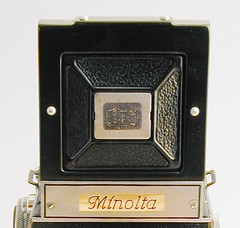
|
| Viewing hood with MTS logo. Picture by eBayer hbpartner. (Image rights) |
The viewfinder provides automatic parallax correction via a mask on the ground glass screen, which moves back and forth when the focus knob is turned.[7] The four-fold viewing hood is much inspired by that of the Ikoflex II. It contains a large magnifying lens hinged to the front. The middle part of the hood has the shape of a truncated pyramid and can be pushed back, revealing a built-in sportsfinder. The silver nameplate is simply marked Minolta; two different variations are known to exist, with a straight or slanted typeface. The center of the viewing hood has a logo, reading MTS on the early cameras and TIYOKO on the late ones.
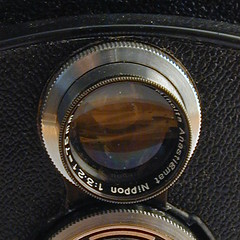 
|
| Left: Minolta Anastigmat Nippon 75mm f/3.2 viewing lens no.11616. Right: Promar Anastigmat Nippon 75mm f/3.5 taking lens no.91611 in a Crown II shutter (B, 1–300). Pictures by eBayer hbpartner. (Image rights) |
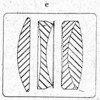
|

|
| Scheme and description of the Promar lens. (Image rights) |
The camera has a Promar 75mm f/3.5 four-element taking lens, made by Asahi Kōgaku (predecessor of Pentax),[8] the same lens as on the Auto Semi Minolta; the marking on the rim is Promar Anastigmat Nippon or Promar Nippon. The viewing lens is a 75mm f/3.2, marked Minolta Anastigmat Nippon or Minolta Nippon, reportedly made by the Chiyoda company itself, perhaps in the Sakai plant.[9] Both lenses take 28.5mm diameter push-on accessories.[10]
The shutter is either an imported Compur (T, B, 1–300) or a Crown II (T, B, 1–300 or B, 1–300) made by Chiyoda itself. It is turned 90 degrees: the speed scale is to the left and the aperture scale is to the right (as seen from the front). On the Compur shutter, the name Compur is inscribed at the bottom and Deckel's FD logo is at the top. The Crown shutter has the name CROWNⅡ–TIYOKO inscribed on a small plate screwed to the left, and three metal stripes above and below the lens. The main release lever is on the photographer's right; the cocking lever is at the bottom of the shutter housing, and also acts as a secondary release lever. Double exposure prevention is provided in two ways: the cocking lever cannot move and the main release lever does not go back to its initial position unless the advance knob is turned.[11]
The dimensions are 98×100×138mm, and the weight is 900g.[12]
Introduction and commercial life

|
| Minoltaflex in the July 1938 catalogue and price list by Asanuma Shōkai. Scan by A. Apra. (Image rights) |
The development of the Minoltaflex was undertaken from 1936 by the Molta company. It reportedly took place in the Amagasaki (尼崎) plant, founded the same year as the subsidiary Nihon Kōgaku Kikai Kenkyūjo, later merged into the main company.[13] The development team was led by Kitakaze Kumatarō (北風熊太郎), director of the factory.[13] It is said that the first prototypes were completed in July 1936.[14]
The camera was released in late 1937, after the Molta company became Chiyoda Kōgaku Seikō. It was featured and advertised in Japanese magazines dated December 1937,[15] and it was displayed at the show organized the same month in the Tōkyō Kaikan by Chiyoda Kōgaku Seikō and Asanuma Shōkai to celebrate new commercial agreements.[16]
Early advertisements show the camera with a Compur shutter and the Minolta name in a straight typeface.[17] The advertisement in Ars Camera December 1937, gives no price and presents the camera as "available soon" (近日発売);[18] the price of ¥245 was announced in the advertisement published the next month in Asahi Camera.[19]
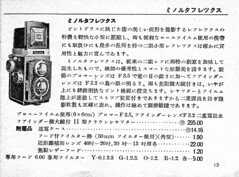
|
| Minoltaflex in the October 1941 catalogue by Asanuma Shōkai. (Image rights) |
The July 1938 catalogue by Asanuma Shōkai mentions the Crown II shutter with T setting, but the illustration still shows the version with Compur shutter and straight typeface; the price is unchanged at ¥245.[20] In the February 1940 advertisement in Asahi Camera, the pictured camera has the Crown shutter and slanted typeface; the price is given as ¥275.[21] In the official list of set prices published in January 1941, the Minoltaflex is mentioned for ¥252, a unique price set for all the 6×6 TLR models.[22] The price was gradually raised throughout the period, and it appears as ¥295 in the October 1941 catalogue by Asanuma Shōkai reproduced here.[23] In the latter, the pictured camera still has the MTS logo on the viewing hood, perhaps because an outdated illustration was used. The Minoltaflex is mentioned in the April 1943 government inquiry on Japanese camera production,[24] and the last reported advertisement is dated September 1943;[25] the production was probably stopped around that time.
It seems that one of the TLR models made by the Chiyoda company was supplied to the military and received an official inventory name. An interview of Tashima Gizō reports that the civilian "Flex" (probably meaning the original Minoltaflex) was supplied as the "portable camera type 99 or something" (99式だったか何かの手持ち写真機), and thus benefited from the allocation of better materials such as stainless steel or aluminium.[26] However Awano suggests instead that the military model was the Minoltaflex Automat.[27]
Variations on actual examples
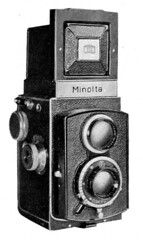
|
| Minoltaflex, Compur shutter (T, B, 1–300), straight typeface. From the July 1938 catalogue by Asanuma Shōkai. (Image rights) |
The early version with the Minolta name in straight typeface seems very rare. At least one surviving example is known with the Compur shutter; its body number is 3186, and both lens numbers are in the 32xx range.[28] Another camera is known with the straight typeface and a Crown shutter, again with four-digit lens numbers.[29]
 
|
| Minoltaflex: straight and slanted typeface. |
All the other cameras have a slanted typeface for the Minolta name. None of these has been observed with a Compur shutter. The import of German shutters certainly stopped in 1937, after the outbreak of war with China, and the stock of Compur shutters perhaps ran out before the switch to the newer nameplate.
The early examples with slanted typeface have a Crown shutter with a T setting, and have four-digit taking and viewing lens numbers (up to the 93xx range).[30]
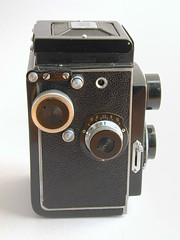 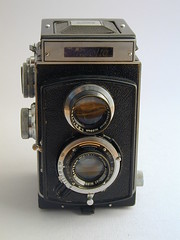  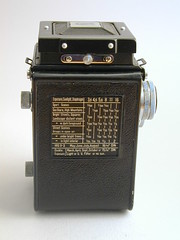
|

|

| |
| Minoltaflex no.9425, Crown II shutter (B, 1–300), Promar Anastigmat Nippon 75mm f/3.5 taking lens no.91611, Minolta Anastigmat Nippon 75mm f/3.2 viewing lens no.11616, MTS logo. Pictures by eBayer hbpartner. (Image rights) | |
All the other known examples have a Crown shutter with no T setting. One isolated example has taking lens no.801x1 and viewing lens no.80862; these numbers might correspond to a small batch of lenses produced immediately after the drop of the four-digit sequence.[31] After that, the numbering of the viewing lens was perhaps reset at 10000; for the taking lens, two isolated numbers are known in the 83xxx and 84xxx range along with an anomalous 10024,[32] then the sequence jumped to c.89000. The bulk of the observed surviving cameras have body numbers between 8848 and 24073, taking lens numbers between 89913 and 111489, and viewing lens numbers between 10775 and 27516. The three numbering sequences were shared with the Minoltaflex Automat.
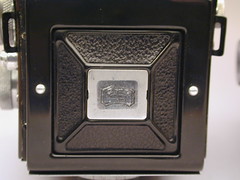 
|
| Viewing hoods of the Minoltaflex no.9425 (MTS logo) and no.22843 (TIYOKO logo). Pictures by eBayer hbpartner. (Image rights) |
The MTS logo present on all the early examples was replaced by the TIYOKO logo around body no.17000. The lens markings were later switched from Promar Anastigmat Nippon to Promar Nippon and from Minolta Anastigmat Nippon to Minolta Nippon; this certainly occurred simultaneously around taking lens no.106000 and viewing lens no.23000.
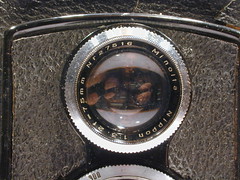 
|
| Lenses of the Minoltaflex no.22843. Left: Minolta Nippon 75mm f/3.2 viewing lens no.27516. Right: Promar Nippon 75mm f/3.5 taking lens no.110967 in Crown II shutter (B, 1–300). Pictures by eBayer hbpartner. (Image rights) |
The exposure table was removed on the last examples, and the crackled black paint inside the back was replaced by matter black, as shown on the very late example pictured below. At least one other late camera has been observed with the red window moved to the middle of the back and an accessory shoe added to the left-hand side, but these features are probably not original.[33]
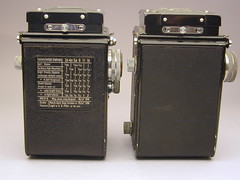 
|
| Minoltaflex no.9425 and no.22843 side by side. Picture by eBayer hbpartner. (Image rights) |
Accessories
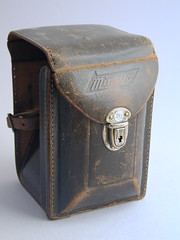 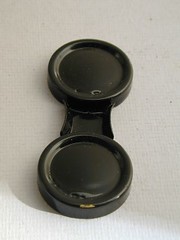
|
| Ever-ready case with Minolta logo, and lens cap. Pictures by eBayer hbpartner. (Image rights) |
It seems that the camera was supplied with a lens cap only. In the catalogues by Asanuma Shōkai dated July 1938 and October 1941, the following accessories are offered separately:
- ever-ready case, ¥8 in 1938, ¥14.16 in 1941;
- filter holder with square hood, 28.5mm push-on mount, taking 30mm diameter filters, ¥1.90;
- hood, 28.5mm push-on mount, ¥6;
- filters, ¥5 each, (Y1, Y2, Y3, G1, G2, R1 available in 1938, Y0, G3, O1, O2, R2 added in 1941);
- close-up lens set: No.1 for 40in to 20in and No.2 for 20in to 13in, ¥22 each;
- leather focusing hood, ¥1.20.
The ever-ready case is made of brown leather; it has either Minoltaflex or a Minolta logo on the front, above the latch. The original double lens cap is black and has no marking.
 
|
| Ever-ready case with Minolta logo, and lens cap. Pictures by eBayer hbpartner. (Image rights) |
The dedicated filters are rare; at least one has been observed with a black rim engraved Minoltaflex Filter. The close-up lens set is contained in a small leather case with a Minoltaflex embossing. It was copied on the Proxar and Rolleipar set of the Rolleiflex, and consists of two identical lenses, inscribed 28.5 and P.X–No.1 or P.X–No.2, and one parallax correction device for the viewing lens, inscribed Minolta Flex and Ro–P.X–No.1 or Ro–P.X–No.2.
Production estimate

|
| Serial number inside the back. (Image rights) |
The Minoltaflex was made in the Amagasaki (尼崎) plant (which produced the bakelite and TLR models) at a rate of about 300–350 units per month.[34]
It is difficult to give a precise estimate of the total production, because the numbering sequence was common to the Minoltaflex and Minoltaflex Automat. From the known serial numbers, it seems certain that less than 25,000 were made of these two models; for the original Minoltaflex alone, we can attempt a rough estimate of 12,000 to 15,000 units, which is consistent with the monthly rate told above.
Notes
- ↑ The camera is referred to in advertising as ミノルタフレックス (Minorutafurekkusu), obviously a compound of "Minolta" and "flex". The decision whether to refer to this as "Minoltaflex" or "Minolta Flex" — one word or two — is rather arbitrary.
- ↑ The name "Minoltaflex I" was introduced after 1945, to distinguish the camera from the postwar Minoltaflex (II), IIB and III.
- ↑ The earliest known occurrence of this mistake is in retrospective accounts published by Minolta's predecessor Chiyoda Kōgaku Seikō in Shashin Kōgyō September 1958: article by Taniguchi on p.276 and chronology "Hensen kamera ichiran-pyō" on p.295 (the latter is reproduced in this Flickr page by Rebollo_fr).
- ↑ Awano, p.3 of Camera Collectors' News no.114, and Tanimura, p.439 of Kokusan kamera no rekishi.
- ↑ The function of this button is described in Hayashi, p.133 of Kurashikku Kamera Senka no.4.
- ↑ Sequence described in Hayashi, p.133 of Kurashikku Kamera Senka no.4.
- ↑ Device described in Hayashi, p.133 of Kurashikku Kamera Senka no.4.
- ↑ Made by Asahi: "Kokusan shashinki no genjōchōsa" ("Inquiry into Japanese cameras"), lens item Lb39; Lewis, p.182.
- ↑ Made by Chiyoda: Kikan Classic Camera 14, p.38. The same source says on p.15 that the Sakai plant produced lenses from 1937, and this is also found in Francesch, p.25.
- ↑ 28.5mm: price list by Asanuma Shōkai dated July 1938, p.3. The close-up lens set sold for the original Minoltaflex is also marked 28.5 (see the picture below).
- ↑ The first feature is mentioned in the catalogue by Asanuma Shōkai dated July 1938, p.3, the second is mentioned in Hayashi, p.133 of Kurashikku Kamera Senka no.4, and both have been checked on an actual example.
- ↑ Scheibel, p.23, and Kikan Classic Camera 14, p.38. (Tanaka, p.25 of Kurashikku Kamera Senka no.12, says 98×100×195mm).
- ↑ 13.0 13.1 Kikan Classic Camera 14, p.15.
- ↑ Fifty-year history Minolta 50-nen no ayumi, p.5.
- ↑ Kokusan kamera no rekishi, p.342.
- ↑ Tashima Gizō, interviewed by Saeki Kakugorō on p.77 of Kurashikku Kamera Senka no.12, says November 1937, but Awano, p.7 of the same magazine, specifies that the show was inaugurated on December 12, 1937.
- ↑ Advertisement in Ars Camera December 1937 reproduced in Kokusan kamera no rekishi, p.98; advertisement in Asahi Camera January 1938 reproduced in Tanimura, p.15 of Camera Collectors' News no.118; advertisement in Asahi Graph, 23 March 1938, formerly reproduced in the Gochamaze website (archived).
- ↑ Advertisement reproduced in Kokusan kamera no rekishi, p.98.
- ↑ Advertisement reproduced in Tanimura, p.15 of Camera Collectors' News no.118.
- ↑ Catalogue by Asanuma Shōkai dated July 1938, p.4, and corresponding price list, p.3.
- ↑ Advertisement reproduced in Kokusan kamera no rekishi, p.98.
- ↑ "Kokusan shashinki no kōtei kakaku", type 7, section 1.
- ↑ Catalogue by Asanuma Shōkai dated October 1941, p.13.
- ↑ "Kokusan shashinki no genjōchōsa" ("Inquiry into Japanese cameras"), item 120. In this document, "Ref" is used instead of "Flex" to name the TLR models, and the name is therefore given as "Minolta Ref" (ミノルタレフ) instead of "Minoltaflex".
- ↑ The advertisement in Shashin Bunka September 1943 is the last one listed in Kokusan kamera no rekishi, p.342.
- ↑ Tashima Gizō, interviewed by Saeki Kakugorō on p.78 of Kurashikku Kamera Senka no.12.
- ↑ Awano, p.17 of Kurashikku Kamera Senka no.12.
- ↑ Data reported from a private collection.
- ↑ Example pictured in Francesch, p.86.
- ↑ Example pictured in this page (archived) of Shintake Shashinkan, example pictured in the 70th anniversary Minolta poster, example pictured in Kokusan kamera no rekishi, p.13, and examples observed in online auctions.
- ↑ Example pictured in this page at Neco's collection.
- ↑ Examples observed in online auctions.
- ↑ Example pictured in this page at Kan's Room (taking lens no.107833).
- ↑ Mukogawa plant: Awano, p.7 of Kurashikku Kamera Senka no.12. Monthly production: Tashima Gizō, interviewed by Saeki Kakugorō on p.78 of Kurashikku Kamera Senka no.12.
Bibliography
Original documents
- Asanuma Shōkai. Cameras — All other apparatus and materials — 1938. Catalogue dated July 1938, p.4, and corresponding price list, p.3. Documents partly reproduced in this Flickr album by Rebollo_fr.
- Asanuma Shōkai. Shashinki to zairyō (写真機と材料, Cameras and supplies). Catalogue dated October 1941, p.13. Document partly reproduced in this Flickr album by Rebollo_fr.
- "Kokusan shashinki no genjōchōsa" (国産写真機ノ現状調査, Inquiry into Japanese cameras), listing Japanese camera production as of April 1943. Reproduced in Supuringu kamera de ikou: Zen 69 kishu no shōkai to tsukaikata (スプリングカメラでいこう: 全69機種の紹介と使い方, Let's try spring cameras: Presentation and use of 69 machines). Tokyo: Shashinkogyo Syuppan-sha, 2004. ISBN 4-87956-072-3. Pp.180–7. Item 120.
- "Kokusan shashinki no kōtei kakaku" (国産写真機の公定価格, Set prices of the Japanese cameras), listing Japanese camera production as of October 25, 1940 and setting the retail prices from December 10, 1940. Published in Asahi Camera January 1941 and reproduced in Shōwa 10—40nen kōkoku ni miru kokusan kamera no rekishi (昭和10〜40年広告にみる国産カメラの歴史, Japanese camera history as seen in advertisements, 1935—1965). Tokyo: Asahi Shinbunsha, 1994. ISBN 4-02-330312-7. Pp.108—9. Type 7, section 1.
Official historical accounts
- Minolta Camera. Minolta 50-nen no ayumi (Minolta・50年のあゆみ, Minolta 50-year history). November 1978. Pp.5–6 and 65.
- Shashin Kōgyō no.77 (September 1958). "Hensen kamera ichiran-pyō" (変遷カメラ一らん表, Table of camera evolution.) P.295. (This is a chronology of Minolta cameras from the Nifcarette onwards. This document is reproduced in this Flickr page by Rebollo_fr.)
- Taniguchi Masao (谷口匡男), from the commercial department (営業部) of Chiyoda Kōgaku Seikō. "Minoruta kamera no sakujitsu, konnichi" (ミノルタ・カメラの昨日、今日, Minolta cameras, yesterday and today). In Shashin Kōgyō no.77 (September 1958). Pp.275–9. (The two first pages of this document, on pre-1937 cameras, are also reproduced in Tanimura, p.8 of Camera Collectors' News no.116.)
Recent sources
- Asahi Camera (アサヒカメラ) editorial staff. Shōwa 10–40nen kōkoku ni miru kokusan kamera no rekishi (昭和10–40年広告にみる国産カメラの歴史, Japanese camera history as seen in advertisements, 1935–1965). Tokyo: Asahi Shinbunsha, 1994. ISBN 4-02-330312-7. Item 279. (See also on pp.13 and 439.)
- Awano Mikio (粟野幹男). "Minoruta ryakushi" (ミノルタ略史, Minolta short history). Kamera Rebyū: Kurashikku Kamera Senka (カメラレビュー クラシックカメラ専科) / Camera Review: All about Historical Cameras no.12, October 1988. No ISBN number. Minoruta kamera no subete (ミノルタカメラのすべて, special issue on Minolta). Pp.6–8.
- Awano Mikio (粟野幹男). "Senzen no Minoruta kamera" (戦前のミノルタカメラ, Prewar Minolta cameras). Kamera Rebyū: Kurashikku Kamera Senka (カメラレビュー クラシックカメラ専科) / Camera Review: All about Historical Cameras no.12, October 1988. No ISBN number. Minoruta kamera no subete (ミノルタカメラのすべて, special issue on Minolta). Pp.13–7.
- Baird, John R. The Japanese Camera. Yakima, WA: Historical Camera Publications, 1990. ISBN 1-879561-02-6. Pp.38 and 42.
- Eimukku 735, Manyuaru Kamera Shirīzu 15 (エイムック735・マニュアルカメラシリーズ15). Minolta: Minoruta kamera no subete (Minolta:ミノルタカメラのすべて, Minolta: all of Minolta cameras). Tokyo: Ei Shuppansha, 2003. ISBN 4-87099-923-4. "Minoruta nigan-refu no yūwaku" (ミノルタ二眼レフの誘惑", Seduction of Minolta TLR cameras). Pp.135–6.
- Francesch, Dominique and Jean-Paul. Histoire de l'appareil photographique Minolta de 1929 à 1985. Paris: Dessain et Tolra, 1985. ISBN 2-249-27685-4. Pp.24–5 and 86–7.
- Hagiya Takeshi (萩谷剛). "Kōkoku ni miru Minoruta kamera no rekishi" (広告に見るミノルタカメラの歴史, "Minolta camera history seen through the advertisements"). Kamera Rebyū: Kurashikku Kamera Senka (カメラレビュー クラシックカメラ専科) / Camera Review: All about Historical Cameras no.12, October 1988. No ISBN number. Minoruta kamera no subete (ミノルタカメラのすべて, special issue on Minolta). Pp.9–12.
- Hayashi Teruaki (林輝昭). "Wagakuni ni-gan-refu no sutandādo Minorutafurekkusu" (わが国二眼レフのスタンダードミノルタフレックス, The Minoltaflex, our country's standard TLR). Kamera Rebyū: Kurashikku Kamera Senka (カメラレビュー クラシックカメラ専科) / Camera Review: All about Historical Cameras no.4, March 1984. No ISBN number. Meiki no keifu (名機の系譜, special issue on famous camera families). Pp.133–5.
- The Japanese Historical Camera. 2nd ed. Tokyo: JCII Camera Museum, 2004.
- Kikan Classic Camera 14 Tokushū: Minoruta Rokkōru densetsu (季刊クラシックカメラ14・特集ミノルタロッコール伝説, special: Minolta Rokkor legend). Tokyo: Futabasha, 2002. ISBN 4-575-47427-4. Pp.15 and 38–9.
- Lewis, Gordon, ed. The History of the Japanese Camera. Rochester, N.Y.: George Eastman House, International Museum of Photography & Film, 1991. ISBN 0-935398-17-1 (paper), 0-935398-16-3 (hard). Pp.39 and 54.
- McKeown, James M. and Joan C. McKeown's Price Guide to Antique and Classic Cameras, 12th Edition, 2005-2006. USA, Centennial Photo Service, 2004. ISBN 0-931838-40-1 (hardcover). ISBN 0-931838-41-X (softcover). P.681.
- Saeki Kakugorō (佐伯恪五郎). "Tashima Gizō-shi ni kiku" (田嶋義三氏に聞く, "Asking Tashima Gizō"). Kamera Rebyū: Kurashikku Kamera Senka (カメラレビュー クラシックカメラ専科) / Camera Review: All about Historical Cameras no.12, October 1988. No ISBN number. Minoruta kamera no subete (ミノルタカメラのすべて, special issue on Minolta). Pp.76–9.
- Scheibel, Anni Rita and Joseph. 70 Jahre Minolta Kameratechnik — Von der Nifcalette bis zur Dynax 9. Stuttgart: Lindemanns Verlag, 3rd edition, 1999. ISBN 3-89506-191-3. Pp.22–3.
- Sugiyama, Kōichi (杉山浩一); Naoi, Hiroaki (直井浩明); Bullock, John R. The Collector's Guide to Japanese Cameras. 国産カメラ図鑑 (Kokusan kamera zukan). Tokyo: Asahi Sonorama, 1985. ISBN 4-257-03187-5. Item 2013.
- Tanaka Masao (田中政雄). "Minolta Camera: nigan-refu kamera" (Minolta Camera: 二眼レフカメラ, Minolta TLR cameras). Kamera Rebyū: Kurashikku Kamera Senka (カメラレビュー クラシックカメラ専科) / Camera Review: All about Historical Cameras no.12, October 1988. No ISBN number. Minoruta kamera no subete (ミノルタカメラのすべて, special issue on Minolta). Pp.25–30.
- Tanaka Masao (田中政雄). Nigan-refu no hanashi (zenpen) (二眼レフのはなし[前編], TLR stories [first part]). Gendai Kamera Shinsho (現代カメラ新書) no.68. Tokyo: Asahi Sonorama, 1980. No ISBN number. Pp.127–9.
- Tanaka Masao (田中政雄). "Nigan-refu no hanashi 2" (二眼レフのはなし2, TLR stories 2). In Camera Collectors' News no.21 (March 1979). Nishinomiya: Camera Collectors News-sha. Pp.11–4. (Contains a picture of a Minoltaflex and a few specifications.)
- Tanimura Yoshihiko (谷村吉彦). "Semi Minoruta I-gata to II-gata." (セミミノルタⅠ型とⅡ型, "Semi Minolta I and II") In Camera Collectors' News no.116 (February 1987). Nishinomiya: Camera Collectors News-sha. (Contains a reproduction of the articles in Shashin Kōgyō no.77 and no other information on the Minoltaflex.)
- Tanimura Yoshihiko (谷村吉彦). "Semi Minoruta I-gata to II-gata (sono 2)." (セミミノルタⅠ型とⅡ型(その2), "Semi Minolta I and II (part 2)") In Camera Collectors' News no.118 (April 1987). Nishinomiya: Camera Collectors News-sha. (Contains a reproduction of an advertisement showing the Auto Minolta, and no other information on the Minoltaflex.)
- Watakushi no ni-gan-refu kamera-ten (私の二眼レフカメラ展, Exhibition of twin lens reflex cameras). Tokyo: JCII Camera Museum, 1992. (Exhibition catalogue, no ISBN number.) P.19.
Links
General links
In English:
- Minoltaflex (I) in the 70th anniversary Minolta poster, reproduced at Photoclub Alpha
- Minolta TLR cameras at TLR Cameras
In Japanese:
- Minoltaflex (I) in the Konica Minolta official history site
- Minoltaflex (I) at TLR milestone
- Minoltaflex (I) at Neco's camera collection, with more pictures here and here
- Minoltaflex (I) among Minolta TLR cameras at Asacame
- Minoltaflex (I) at www.syakazuka.com
- Minoltaflex (I) in the Camera database of the Center of the History of Japanese Industrial Technology
- Restoration of a Minoltaflex (I) at Kan's Room, with sample pictures
Original documents
In Japanese:
- Advertisement for the Minoltaflex published in the May 1940 issue of Asahi Camera, reproduced in this page of the Heiki Seikatsu website. It is the fifth advertisement from the top.
| Nifca, Molta and Chiyoda prewar and wartime cameras () | |
|---|---|
| folding plate cameras | |
| Nifcaklapp | Nifcasport | Sirius | Arcadia | Lomax | Eaton | Happy | |
| folding rollfilm cameras | telescopic bakelite cameras |
| Nifcarette | Sirius Bebe | Semi Minolta | Auto Semi Minolta | Minolta Vest | Baby Minolta | Minolta Six |
| strut-folding cameras | TLR cameras |
| Nifca-Dox | Minolta | Auto Minolta | Auto Press Minolta | Minoltaflex | Minoltaflex Automat | Minoltaflex military prototype |
